Building Loyalty Through Omnichannel Customer Communications
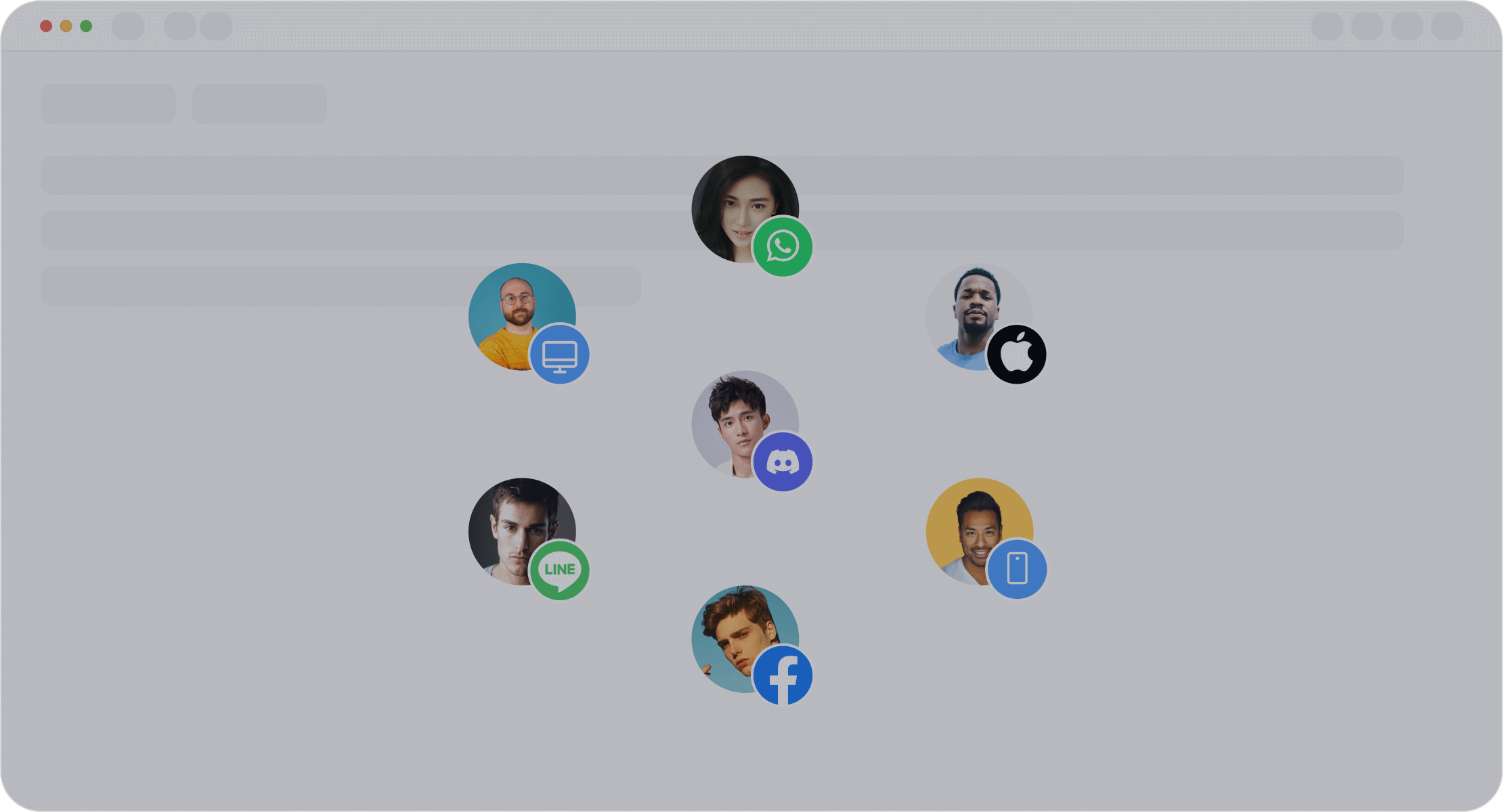
Omnichannel customer communications create a seamless omnichannel experience that builds trust and loyalty. Companies that deliver a consistent, personalized experience across every channel see dramatic results. For example, businesses with strong omnichannel communication strategies achieve an 89% retention rate, while those with weak strategies reach only 33%.
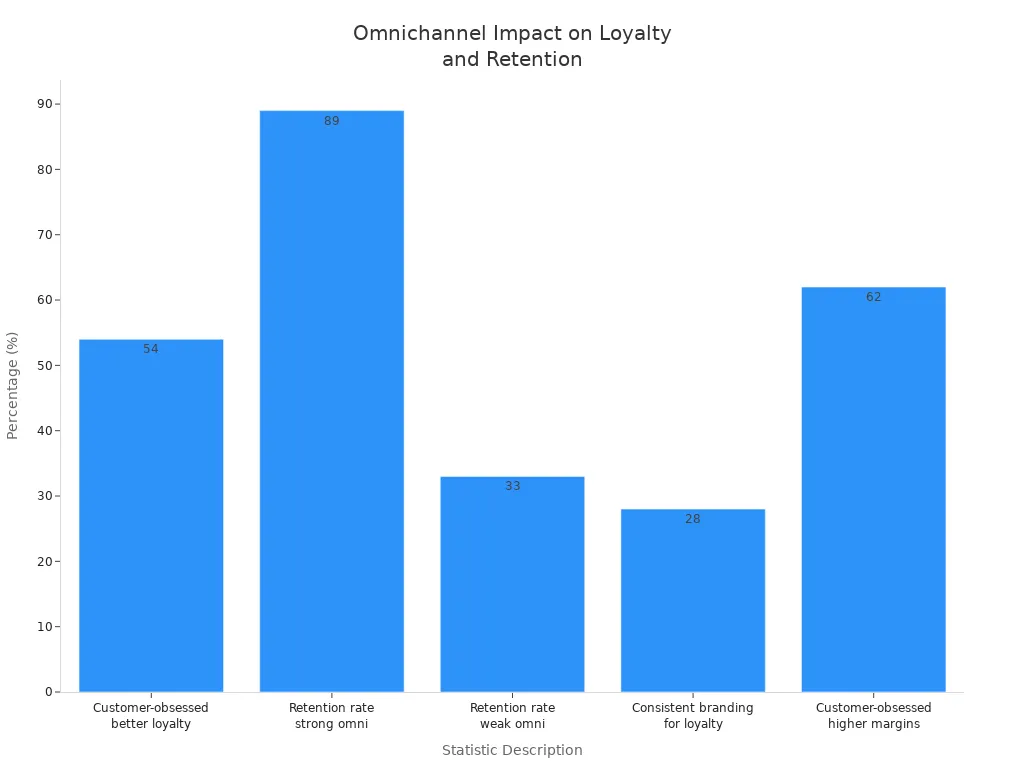
Sobot empowers brands to exceed customer expectations through seamless omnichannel experience, with Sobot AI and Sobot call center solutions helping companies like Opay increase customer satisfaction from 60% to 90%. When customers trust a brand to deliver personalized experiences on their preferred platforms, loyalty and advocacy follow.
Omnichannel Customer Communications
What Is Omnichannel?
Omnichannel customer communications bring every brand channel together to create a seamless, unified customer experience. Unlike multichannel approaches, which treat each channel as separate, an omnichannel strategy connects all touchpoints. This means customers can move from a website to a mobile app or from social media to in-store support without losing context or information. For example, a shopper can add items to a cart on a website and find the same cart ready on their mobile app. Omnichannel communication focuses on consistency, personalization, and a holistic customer journey, while multichannel strategies often focus on product promotion within each channel.
Why It Matters for Loyalty
A strong omnichannel strategy helps build trust and satisfaction. Customers expect brands to remember their preferences and provide real-time information, no matter where they interact. Companies that use omnichannel customer communications see higher satisfaction because they offer convenience and consistency. Personalized offers and tailored messages, powered by data and AI, make customers feel valued. Research shows that 70% of customers report more personalized experiences and 60% report increased loyalty when brands use AI-driven omnichannel strategies. Brands like Starbucks and Sephora have seen loyalty program growth and higher visit frequency by connecting digital and physical experiences. These results show that a seamless omnichannel customer experience leads to repeat purchases and long-term trust.
Tip: Integrated customer service across all channels ensures customers receive uniform support, which is key to building trust and loyalty.
Sobot’s Approach
Sobot stands out as a leader in omnichannel customer communications. The platform serves over 10,000 brands worldwide, including Samsung, OPPO, and Michael Kors. Sobot’s unified platform brings together live chat, chatbot, voice, ticketing, and WhatsApp Business API, supporting more than 18 languages. With AI-driven features and predictive analytics, Sobot helps brands deliver fast, consistent, and secure communication across every touchpoint. Customer testimonials highlight improved customer experience and operational efficiency. Sobot’s commitment to innovation and customer-centric solutions makes it a trusted partner for companies seeking to enhance their omnichannel strategy and build lasting loyalty.
Seamless Omnichannel Experience
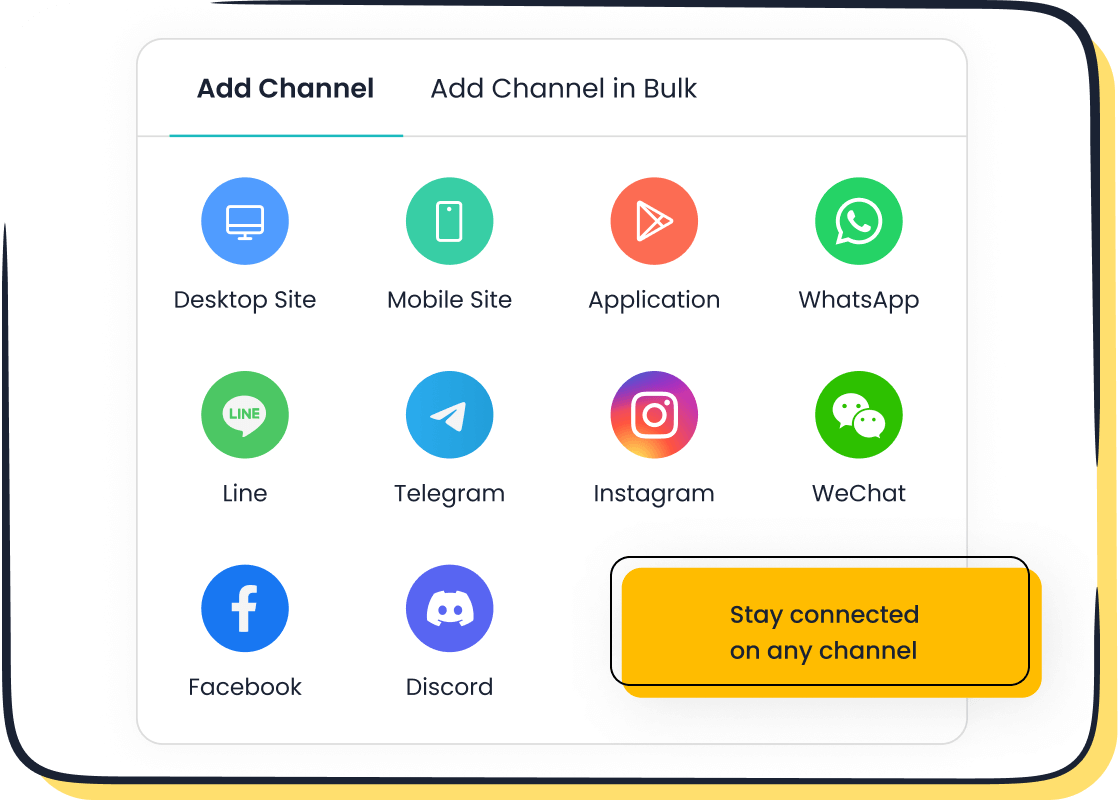
Integrating Channels
A seamless omnichannel experience starts with integrating every customer contact channel. Companies connect voice, chat, social media, and email to create a single, unified platform. This integration allows support agents to manage all customer interactions in one place. Customers receive help on their preferred channels, which increases satisfaction and loyalty. Businesses see faster ticket resolution and higher productivity because agents do not switch between systems. Sobot’s Omnichannel Solution and live chat bring all channels together, making it easy for teams to deliver a seamless omnichannel experience. AI and automation handle repetitive tasks, so agents focus on complex issues. This approach boosts operational efficiency and enables personalized support at every step of the customer journey. Companies also reduce costs by automating simple requests and improving agent productivity.
Tip: Integrating channels helps remove friction from the customer journey, making every interaction smooth and consistent.
Unified Customer Data
Unified customer data is the backbone of a seamless omnichannel experience. When companies consolidate customer profiles and histories, agents access real-time information during every customer interaction. This unified view means customers never repeat themselves, even when switching from chat to a phone call. Sobot’s Omnichannel Solution provides a centralized workspace, so agents see all past interactions and preferences. The table below shows how unified data improves omnichannel customer service:
| Aspect | Benefit |
|---|---|
| Centralized Customer Data | Agents access full profiles, ensuring consistent service across all channels. |
| Omnichannel Support Systems | Customers switch platforms without losing context, maintaining a seamless experience. |
| AI-Powered Tools | AI uses unified data for accurate, personalized responses and proactive support. |
| Standardized Procedures | Agents follow updated knowledge bases for high-quality, consistent service. |
| Customer Data Matching | Consolidated data eliminates duplicates, improving efficiency and customer experience. |
Unified data also powers analytics, helping companies optimize the customer journey and deliver a seamless omnichannel experience.
Consistency Across Touchpoints
Consistency is key to building trust in omnichannel customer service. Customers expect the same quality of service, no matter where they interact. When companies maintain consistent messaging and support, they increase loyalty and retention. Seamless omnichannel experience ensures customers move between digital and physical touchpoints without confusion. Brands like Disney and Starbucks have shown that consistent experiences lead to higher engagement and sales. Sobot’s unified platform supports this by standardizing responses and using AI to personalize every customer interaction. Businesses see measurable results, such as higher conversion rates and improved customer lifetime value, when they deliver a seamless omnichannel experience throughout the customer journey.
Personalizing Customer Experience
Leveraging Customer Data
Personalization stands at the heart of effective omnichannel customer service. Brands that use customer data to tailor every step of the customer journey see stronger loyalty and higher satisfaction. Studies show that 80% of shoppers ignore irrelevant marketing, while 77% are more likely to buy when they receive relevant recommendations. Companies that remember preferences and recall past customer interactions build trust and encourage repeat business. By unifying data from sources like demographics, browsing behavior, and purchase history, businesses can deliver personalized experiences that match each customer’s needs. Predictive analytics help identify loyal customers and those at risk of leaving, allowing proactive retention strategies. This data-driven approach not only improves customer engagement but also increases retention and lifetime value.
Note: Customers willingly share data for relevant incentives, with 99.6% open to sharing if it leads to better offers and support.
AI and Automation
AI and automation transform omnichannel customer service by making personalization scalable and efficient. Global brands use AI to analyze customer interactions and deliver personalized support across every channel. AI-powered chatbots provide 24/7 assistance, answer questions, and guide users through the customer journey. Machine learning models segment audiences and predict needs, enabling timely, relevant offers. These tools automate repetitive tasks, freeing agents to focus on complex issues and engaging interactions. AI-driven personalization increases customer engagement and satisfaction, as customers receive consistent, contextual messaging wherever they connect.
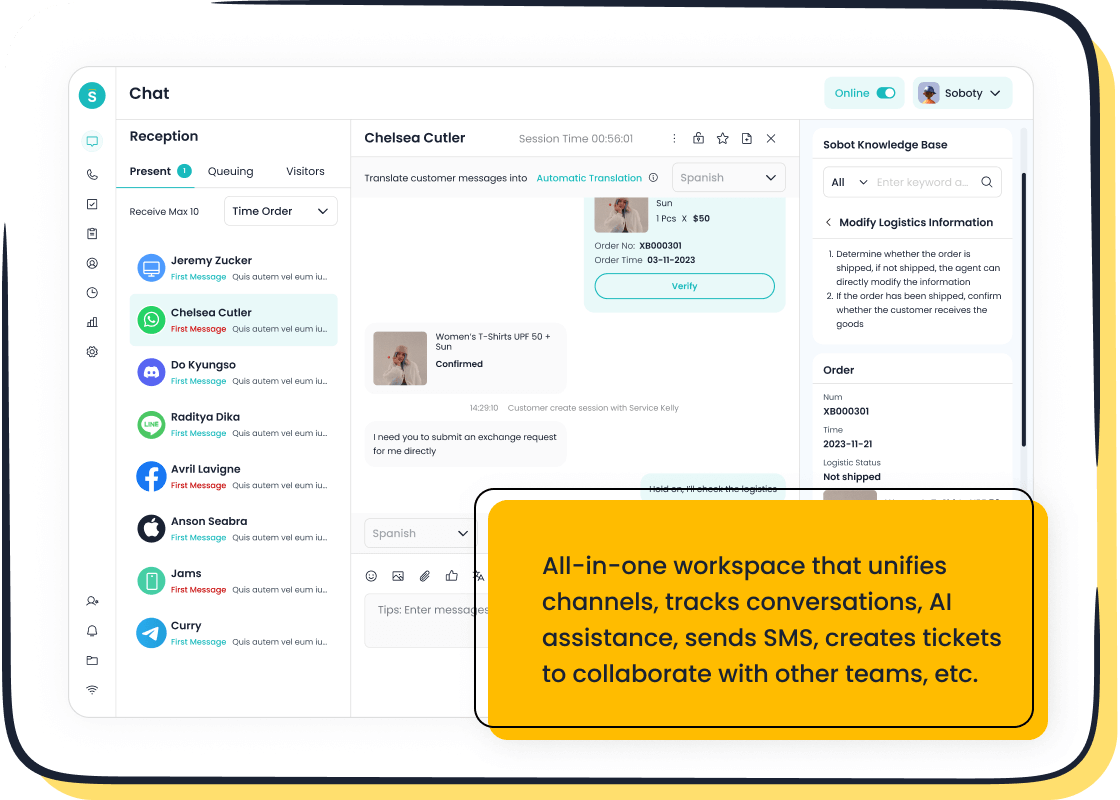
Sobot Live Chat Features
Sobot Live Chat enhances customer experience with advanced features designed for omnichannel engagement. The platform supports seamless integration across websites, apps, social media, email, and calls, ensuring no customer interaction is missed. AI-powered chatbots deliver accurate, contextual responses and can hand off complex queries to live agents. The analytics dashboard tracks over 150 indicators, helping teams optimize service and personalize every touchpoint. Sobot’s multi-language support, proactive engagement tools, and robust CRM integration enable businesses to deliver personalized experiences and personalized support at scale. Companies like Samsung have seen customer satisfaction rise to 97% and agent efficiency improve by 30% after adopting Sobot Live Chat. These results show how a personalized approach and omnichannel customer service can enhance customer experience and drive loyalty throughout the customer journey.
Omnichannel Customer Service Strategies
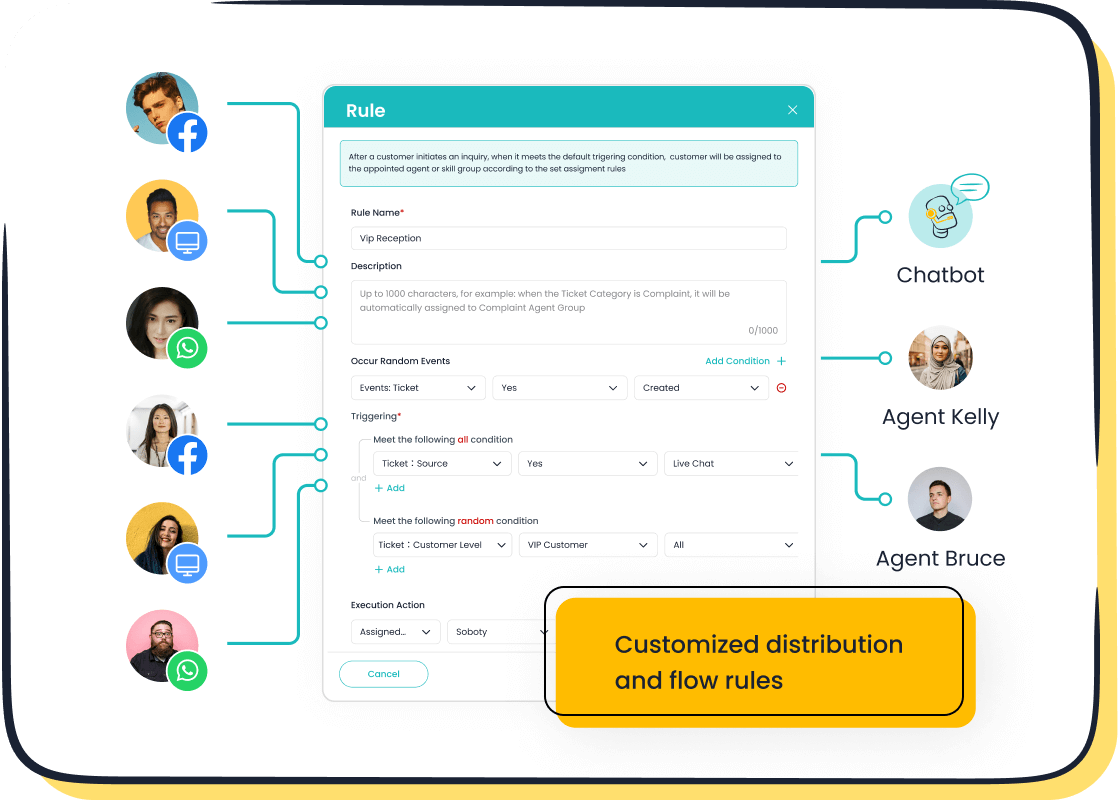
Empowering Teams
Empowering customer service teams is essential for delivering outstanding omnichannel customer service. Companies that want to build loyalty must give their agents the authority and tools to make decisions quickly. When agents can create their own workflows and solve problems without waiting for approval, they resolve issues faster. This approach reduces micromanagement and increases both agent and customer satisfaction.
Successful organizations listen to their agents and appreciate their efforts. Regular feedback sessions and recognition programs boost motivation and performance. Teams that feel valued tend to stay longer and deliver better service, which leads to higher customer loyalty.
Equipping teams with the right tools is another key strategy. Omnichannel helpdesk software, like Sobot’s unified workspace, allows agents to manage all customer interactions from one platform. This integration improves efficiency and job satisfaction. Agents can see every conversation, ticket, and customer profile in real time. They do not need to switch between systems, so they can focus on providing consistent, high-quality support.
Key strategies for empowering teams include:
- Allowing agents to design workflows that fit their style and strengths.
- Providing ongoing professional development to keep skills sharp.
- Listening to agent feedback and recognizing achievements.
- Equipping teams with advanced omnichannel helpdesk software and internal communication tools.
Sobot’s platform supports these strategies by offering a unified workspace, AI-powered tools, and seamless collaboration features. Companies using Sobot report higher agent retention and improved customer satisfaction, which are critical for an effective omnichannel strategy.
Tip: Empowered teams deliver faster, more personalized service, which increases customer satisfaction and loyalty.
Training for Omnichannel
Training programs play a vital role in preparing teams for omnichannel customer service. Companies must invest in comprehensive and customized training that matches their business needs. A successful training program starts with a skills gap analysis. This helps identify areas where agents need improvement. Training should align with business goals and focus on both customer service excellence and technical proficiency across all platforms.
Continuous learning frameworks keep teams adaptable. Regular workshops, e-learning modules, and peer coaching sessions help agents stay updated on new tools and best practices. Partnering with specialized providers ensures access to expert-led training. These programs teach agents how to use omnichannel communication tools and apply strategies that address unique organizational challenges.
A seamless training experience includes:
- Initial assessment to understand team strengths and weaknesses.
- Customized program delivery that covers all aspects of omnichannel customer service.
- Ongoing follow-up to ensure agents apply new skills effectively.
Sobot supports training by providing intuitive interfaces and built-in guidance within its omnichannel helpdesk software. New agents can quickly learn how to manage conversations across channels, use AI-assisted tools, and access customer data. This reduces onboarding time and ensures consistent service quality.
Note: Well-trained teams adapt quickly to changes in customer expectations and technology, making them a valuable asset in any omnichannel strategy.
Proactive Support
Proactive support is a cornerstone of effective omnichannel strategy. Companies that anticipate customer needs and reach out before problems arise set themselves apart. Monitoring customer behavior and preferences allows teams to identify potential issues early, such as abandoned carts or repeated questions. This approach reduces customer effort and increases satisfaction.
Offering self-service options, like knowledge bases, FAQs, and AI-driven virtual assistants, empowers customers to find answers quickly. Sobot’s AI-powered chatbots provide 24/7 support, guiding users through common issues and escalating complex cases to live agents when needed. This seamless integration of proactive support within omnichannel customer service ensures faster resolution and a personalized experience.
Training teams to reach out proactively, such as with post-purchase check-ins or follow-up messages, enhances customer engagement. Collecting and acting on customer feedback helps refine services and improve proactive strategies. Companies that use these methods see higher satisfaction rates and stronger brand loyalty.
A table below summarizes the benefits of proactive support in omnichannel customer service:
| Proactive Support Strategy | Benefit |
|---|---|
| Monitoring customer behavior | Early issue identification |
| Self-service options | Reduced customer effort |
| Proactive outreach | Enhanced customer engagement |
| Feedback-driven improvements | Stronger brand loyalty |
| Integrated omnichannel support | Faster, personalized resolutions |
Sobot’s omnichannel communication tools make it easy to implement proactive support. The platform’s analytics help teams spot trends and act quickly. Automated workflows ensure that no customer inquiry goes unnoticed. Companies using Sobot have reported significant improvements in customer satisfaction and operational efficiency.
Callout: Proactive support not only solves problems but also builds trust, which is vital for long-term business success.
Measuring and Optimizing Success
Analytics and Feedback
Analytics and feedback play a central role in optimizing any omnichannel strategy. Companies track customer satisfaction by collecting data from every channel—web, mobile, chat, social media, phone, and surveys. Real-time evaluation of customer conversations gives teams immediate insights. Speech and text analytics powered by Natural Language Understanding reveal customer sentiment and needs. Businesses use in-depth customer profiling to understand behavior and preferences, which leads to better customer satisfaction.
Key metrics for customer satisfaction include Net Promoter Score (NPS), Customer Satisfaction (CSAT) surveys, and Customer Effort Score (CES). These metrics help identify friction points and strengths in the customer journey. Companies also monitor open rates, click-through rates, cart abandonment, and conversion rates. By consolidating zero-party and first-party data into a unified platform like Sobot, businesses gain a 360-degree view of each customer. This approach supports customer experience management and helps teams personalize service, reduce churn, and improve retention.
Tip: Regularly collecting feedback through satisfaction surveys ensures that every customer voice is heard and acted upon.
Continuous Improvement
Continuous improvement keeps an omnichannel strategy effective and relevant. Companies must evaluate performance and adapt based on analytics and customer satisfaction feedback. The table below outlines best practices for continuous improvement:
| Process | Description | Benefit |
|---|---|---|
| Continuous Evaluation and Adaptation | Assess strategy performance and refine using data and feedback | Maintains high satisfaction and loyalty |
| Leverage Automation | Automate repetitive tasks to boost efficiency | Frees staff for complex issues |
| Train Staff on Best Practices | Provide ongoing training for seamless omnichannel communication | Improves service quality and satisfaction |
| Utilize Omnichannel Analytics | Analyze data from all channels for insights | Informs decisions and identifies trends |
| Provide Seamless Cross-Channel Support | Ensure smooth transitions between channels | Enhances customer satisfaction |
| Employ AI and Machine Learning | Use AI for personalization and predictive analytics | Increases conversion and satisfaction |
Sobot’s analytics and automation tools help companies implement these processes. Teams can quickly spot trends, act on feedback, and deliver consistent customer satisfaction.
Sobot Case Study: Opay
Opay, a leading financial service platform, partnered with Sobot to improve customer satisfaction and operational efficiency. Before Sobot, Opay struggled with fragmented communication and low satisfaction scores. After adopting Sobot’s omnichannel solution, Opay unified its customer service across social media, email, and voice channels. The result was a jump in customer satisfaction from 60% to 90%. Opay also reduced operational costs by 20% and increased conversion rates by 17%. The intelligent IVR system allowed 60% of customers to resolve issues independently, boosting satisfaction and reducing agent workload. Opay’s experience shows how a strong omnichannel strategy and advanced analytics drive measurable improvements in customer satisfaction and retention.
Note: Industry benchmarks show that companies with a robust omnichannel strategy achieve an average customer retention rate of 89% (Invesp), far above those with weak strategies.
Overcoming Omnichannel Challenges
Data Integration
Many organizations face significant hurdles when integrating data for omnichannel customer service. Legacy systems often lack modern APIs, which slows down order processing and increases manual errors. Data can become scattered across multiple sources, making it hard to create a single source of truth. Without centralized analytics tools, teams struggle to analyze and unify data from different channels. In industries like healthcare, outdated platforms create data silos and communication gaps. Compliance and security concerns add another layer of complexity, especially in regulated sectors. Staff training and change management are also critical, as employees must adapt to new digital transformation processes.
Sobot addresses these challenges by offering a unified platform that consolidates customer data from all channels. Agents access real-time profiles and histories, which reduces errors and improves service quality. Sobot’s analytics tools help teams gain insights and optimize their strategies. This approach supports seamless digital transformation and ensures that every customer interaction is informed by accurate, up-to-date information.
Tip: Centralized data integration not only improves efficiency but also builds trust with customers by providing consistent service.
Channel Overload
Channel overload happens when customers and agents face too many communication options, leading to confusion and slow responses. Companies can use several strategies to manage this challenge:
- Funnel interactions to faster messaging channels like SMS or live chat before moving to slower channels such as email or phone.
- Promote quick messaging options by displaying contact choices clearly on websites, emails, and social media.
- Offer multichannel support, including phone, email, social media, SMS, and live chat, to meet diverse customer needs.
- Provide self-service resources like FAQs, knowledge bases, and tutorials to help customers solve problems independently.
- Use a unified support platform to centralize conversations and customer data, allowing agents to manage requests efficiently.
- Combine chatbots with live chat to handle simple queries instantly and escalate complex issues to human agents.
- Implement automation workflows and ticket prioritization to streamline operations and reduce agent overload.
Sobot’s omnichannel customer service platform brings all channels together in one workspace. Agents can switch between channels without losing context, and automation features help prioritize urgent requests. This unified approach reduces channel overload and improves both customer and agent experiences.
Privacy and Security
Privacy and security remain top concerns in omnichannel customer service. Collecting data from multiple sources increases the risk of cyberattacks and data breaches. Fragmented data and multiple access points create vulnerabilities. Phishing attacks and human error can also threaten sensitive information. Balancing personalization with privacy is a constant challenge.
Organizations can use several strategies to protect customer data:
- Collect only essential information to reduce exposure.
- Encrypt data at rest and in transit, and use tokenization for payment details.
- Strengthen authentication with Single Sign-On (SSO) and behavioral biometrics.
- Restrict employee access based on the principle of least privilege and enforce zero-trust architecture.
- Educate employees and customers about security risks and privacy controls.
- Maintain transparency about data collection and allow customers to customize privacy settings.
Sobot ensures privacy and security by aligning its platform with country-specific regulations and maintaining internationally recognized certifications in information security, cloud security, and system security. Regional data centers in the United States, Europe, Singapore, and other locations support reliable and secure global performance. Sobot’s commitment to compliance and robust security measures helps organizations build customer trust and meet regulatory requirements.
Note: Strong privacy and security strategies are essential for protecting customer trust and supporting long-term business growth.
Omnichannel communication drives customer satisfaction and loyalty by connecting every touchpoint. Brands like Amazon and Starbucks show that seamless integration, personalization, and empowered teams build strong customer engagement and repeat business. Companies can start by auditing channels, training teams, and using platforms like Sobot Live Chat. Measuring satisfaction and adapting strategies help maintain high performance. Prioritizing omnichannel strategy leads to higher retention, better customer satisfaction, and long-term business growth (source).
FAQ
What is omnichannel customer communications?
Omnichannel customer communications connect every channel—like chat, email, and social media—into one seamless experience. Brands using this approach see up to 89% higher retention rates (Invesp). Sobot Live Chat helps companies unify these channels for better service.
How does a seamless omnichannel experience improve loyalty?
A seamless omnichannel experience lets customers switch between channels without repeating themselves. This builds trust and satisfaction. Sobot’s unified platform ensures every interaction feels connected, which increases loyalty and encourages repeat business.
Why is personalized customer experience important in omnichannel customer service?
Personalized customer experience makes each customer feel valued. Sobot Live Chat uses AI to tailor responses and offers. Research shows 77% of customers buy more when brands personalize communication. Personalization drives higher satisfaction and long-term loyalty.
How does Sobot Live Chat support omnichannel customer service?
Sobot Live Chat brings all conversations—web, app, social, and email—into one workspace. Agents see full customer histories and respond faster. This unified approach improves efficiency and delivers consistent, high-quality omnichannel customer service.
What analytics does Sobot provide for optimizing omnichannel customer communications?
Sobot offers over 150 analytics indicators. Teams track satisfaction, conversion, and agent performance. Real-time data helps companies refine their omnichannel customer communications and deliver a seamless omnichannel experience that meets evolving customer needs.
Tip: Regularly review analytics to keep your omnichannel customer service strategy effective and customer-focused.
See Also
Comprehensive Overview Of Omnichannel Call Center Platforms
Step-By-Step Process For Deploying Omnichannel Contact Centers
Expert Strategies For Live Chat Success In Retail
